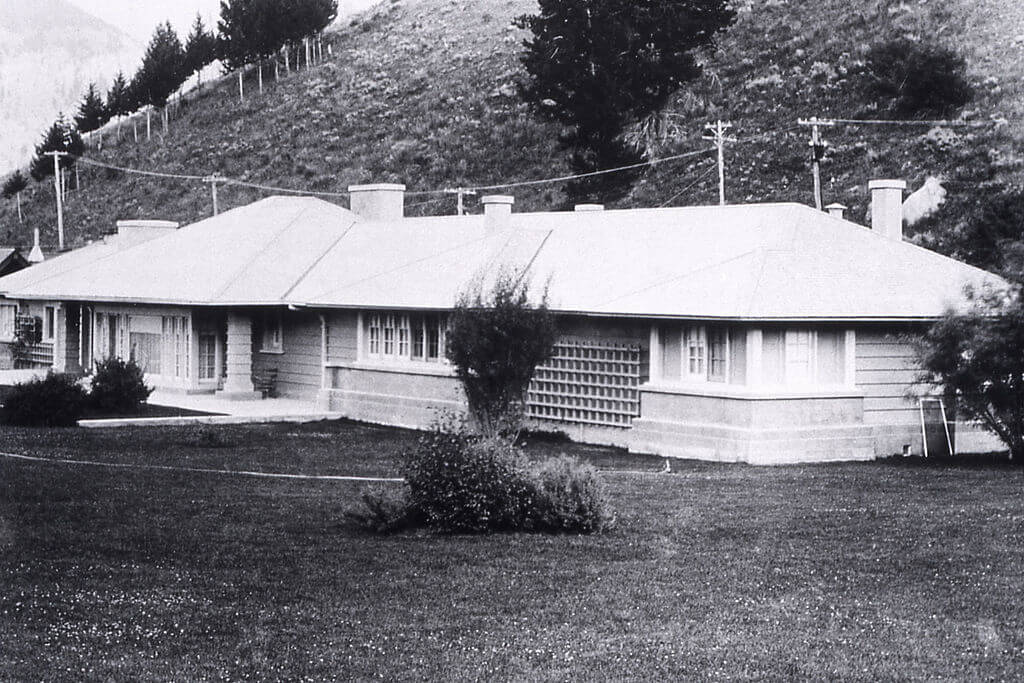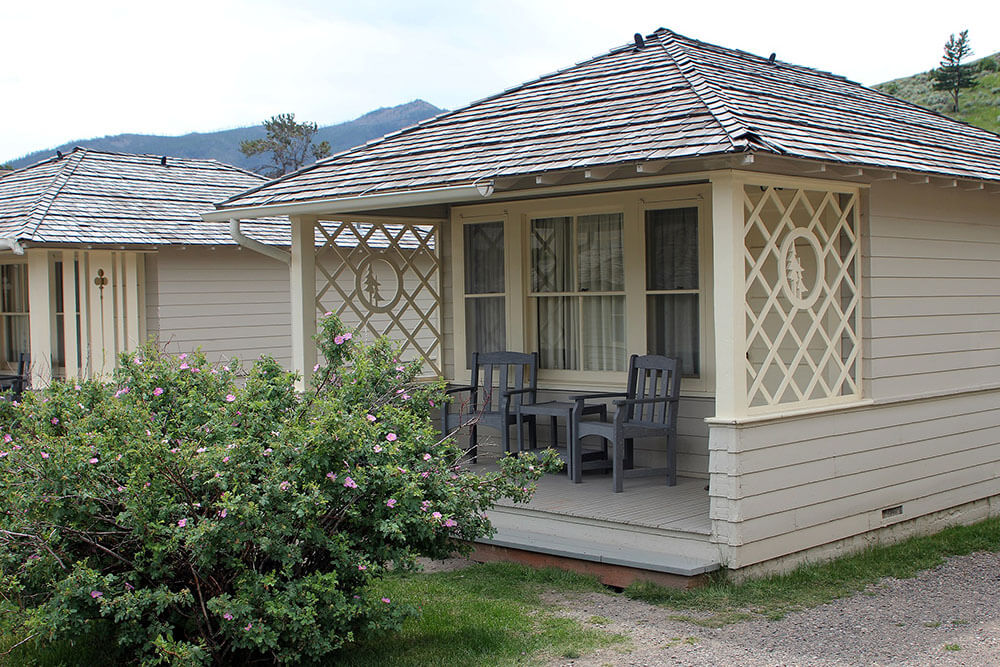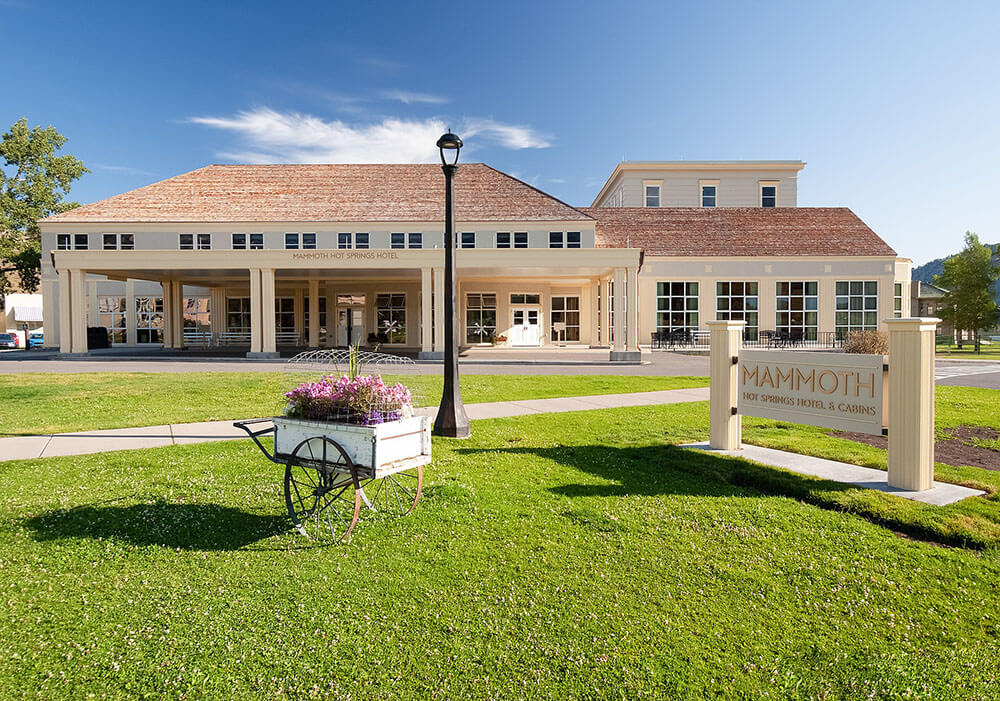Yellowstone National Park is considered a jewel of the National Park Service. This can be attributed to the bountiful wildlife and geological anomalies that grace its landscape. But getting out of the car to explore the historic buildings found here can add to a Yellowstone adventure in a special way.
Hospitality Worth Exploring
Old Faithful Inn

Designed by architect Robert Reamer, Old Faithful Inn was an unprecedented endeavor during its build, which spanned the years 1903-04. Owner of the Yellowstone Park Company, Harry Child, commissioned its design. He was hoping to compete with the luxury hotels of the East. Twenty-nine-year-old Reamer outdid himself. The 7-story inn is still considered the largest log structure in the world. The lower story alone required the use of ten thousand logs.
From a distance, the eye-catching massive roof is a signature draw. Its unique shingle style occupies the top stories of the structure, with dormers scattered throughout. Walking in, a visitor is first struck by the 7-story lobby, with beams of locally sourced timbers and stone prominent in the expansive room. A massive stone fireplace serves as a centerpiece in this space and provides the perfect spot from which to gaze upon the magnificent architectural finishes.
Granted National Historic Landmark status in 1987, the Old Faithful Inn is considered the pioneering structure in the National Park Service rustic design movement, often referred to as “Parkitecture”. Reamer’s ability to design his work as accompaniments to nature offered him an opportunity to show off his aesthetic flexibility. He earned the title “master of all styles.”
Mammoth Designs

In the book Weaver of Dreams, a comprehensive volume on Robert Reamer’s architectural accomplishments, author Ruth Quinn describes Yellowstone’s Executive House as a “low-slung Prairie Style home.” It is considered the only remaining example of Prairie Style architecture in the Rockies. Built in 1908 at Mammoth Hot Springs, it originally served as residence for the Child family.
Many argue that this home was inspired by Frank Lloyd Wright’s Robie House, but overall, it is difficult to identify Reamer’s influences. The shingle style featured on Old Faithful Inn’s roof seems a direct reflection on Scandinavia, but the Executive House and other structures at Mammoth are not at all similar to that, nor are they similar to one another.
The complex of Reamer designed cottages at Mammoth were built between 1937-38. Decorative lattice frames some of the porches, while others feature wood cutouts that are reminiscent of the Arts and Crafts design movement. Compared to the grandiose presence of Mammoth Hot Springs Hotel, these dwellings are decidedly modest.

Built in 1883 in the Queen Anne style, the Mammoth Hot Springs Hotel was given a dramatic facelift between 1911-1913. The fourth floor was removed and the roof flattened. Robert Reamer entered the picture in 1936, when most of that new inal framework was torn down. What he created is a stately, elegant design that does not overpower the surrounding grandeur of nature. In 2019, the National Park Service completed an extensive $30 million rehabilitation and renovation to the historic structure.
Lake Yellowstone Hotel

Another of Yellowstone’s oldest hotels, Lake Yellowstone Hotel was built in 1891. Robert Reamer once again worked his magic when he led a remodel in 1903. The impressive columns he added easily convey the Colonial Revival aesthetic. The yellow color is striking against the vivid blue of the Wyoming sky.
During summer evenings, guests are transported into a calm, artful atmosphere as a string quartet plays in the lobby. This is an upscale experience, aided by a $28.5 million renovation in 2014. Still, the aura of park history remains consistent. There are no televisions or radios in the rooms. The golden age of park touring seems to be embodied in this building, designated a National Historic Landmark in 2015.
The Yellowstone Museum Experience
From 1929 to 1932, architect Herbert Maier designed four museums at Yellowstone, in keeping with Parkitecture. These were located at Fishing Bridge, Norris Geyser, Madison Junction and Old Faithful. The museum at Old Faithful was demolished in 1971, but the surviving structures were all designated as National Historic Landmarks in 1987.
Each of these buildings are distinctive in their rustic presentation. Going even further than Robert Reamer to ensure that the structures were more of an accessory to nature rather than a focal point, Maier sourced local materials that were largely left in their natural condition. Logs are not honed in this aesthetic, and stone pathways and stairs present a bit of an irregular walking surface.
Maier was deeply committed to his vision, and reportedly considered National Park Service buildings a “necessary evil”, even going as far to declare them “intruders.” With the museums in Yellowstone, nature is given her due through the selection of rough boulders and logs, reminding us why we must linger in the beauty of the outdoors.
An Enduring Legacy
The style that is Parkitecture was pioneered by Robert Reamer and filtered its way into multiple national parks throughout the United States. Today, this style of architecture is often referred to as Biophilic design, and its use seeks to bring occupants of the space closer to nature without being invasive to the landscape. What was accomplished in Yellowstone in the early 1900s lives on today. This is a design approach that is pleasing to the eye, but most of all, respectful to the surrounding environment. Discover this historic architecture for yourself with a stay at Yellowstone National Park.
This article was written on behalf of Travel Wyoming by Jenn Rein, New Thought Digital Agency.